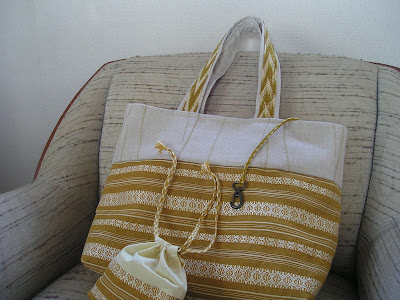春日大社蔵・沃懸地酢漿紋兵庫鎖太刀の佩緒(いかけぢかたばみもんひょうごぐさりたちのさげお)です。
今回使ったスタンドは、T字型のスタンドで、亡くなられた組紐の先生の遺品を多田先生を通じて頂きました。ただ、11本のクテを休ませるにはTの横棒が短すぎるので、上部に物差しを固定しました。
糸の初期設定は、3人とも同じです。
●〇●〇●〇●〇●〇● ●〇●〇●〇●〇●〇●
組み方は、AADDです。クテが11本なので、普通に組んでいくと自然に5段と6段のギザギザ模様ができます。無地にしたいときは、色が変わらないように、ちょっとした秘密の操作(「日本組紐古技法の研究」p.134参照)をします。
略号A, B, C, D については、「クテ打ち手操作基本の4操作」をご覧ください。
I felt like challenging a big task, and I chose this pattern. Three braiders line up side by side, holding 22 kutes, 11 in each hand. That means I have to manipulate 66 kutes all alone. It surely is a big task!
I prepared 11 different color kutes, and 6 different color foot-threads. This preparation alone took one day. I used 3 kute-rest-stands.
The stands I used this time were T-shaped stands, which were memento of a deceased kumihimo teacher. I received them through Tada-sensei. The horizontal bar of the T was too short to rest the 11 kutes, so I fixed a ruler on the top.
The initial color arrangements are the same for all three braiders.
●〇●〇●〇●〇●〇● ●〇●〇●〇●〇●〇●
The braiding technique is AADD. There are 11 kutes, so if you braid them normally, you can naturally get a jagged pattern with 5 and 6 rows. When you want a solid color part, you do a little secret manipulation (ref. “Study of archaic braiding techniques in Japan” p. 134) so that the color doesn’t change.
The upper one in the photo is made with 2-thread Cotton Queen and the lower one with Hamanaka Aprico. Both are shiny and beautiful threads. You can also have chevron patterns on the side. The solid color part is a little narrower due to the secret manipulation. It is a sturdy braid that is about half as thick as it is wide.















